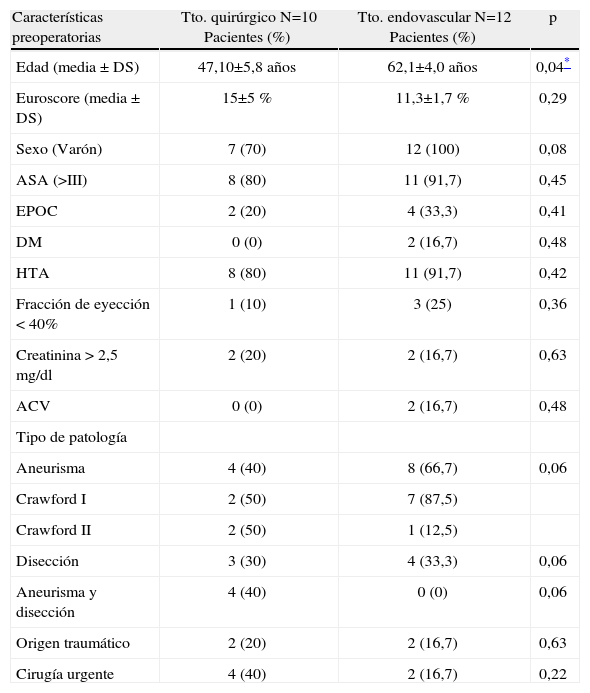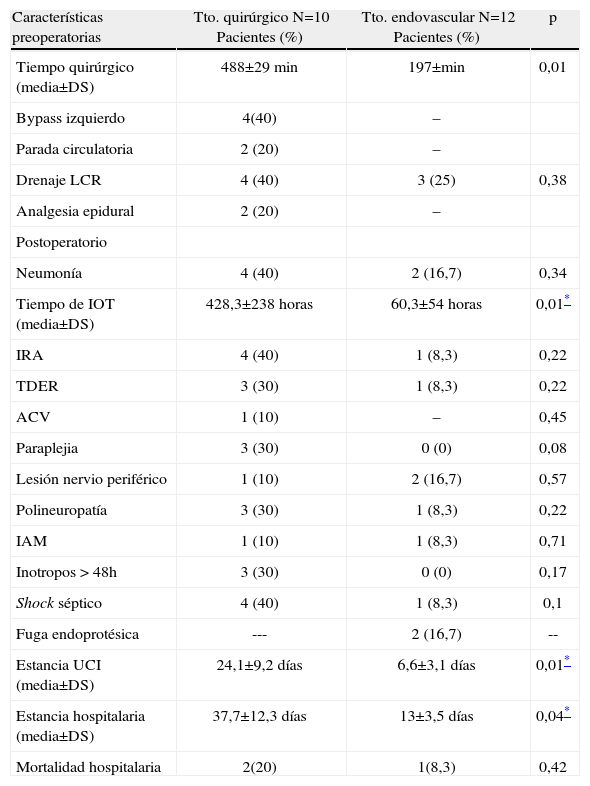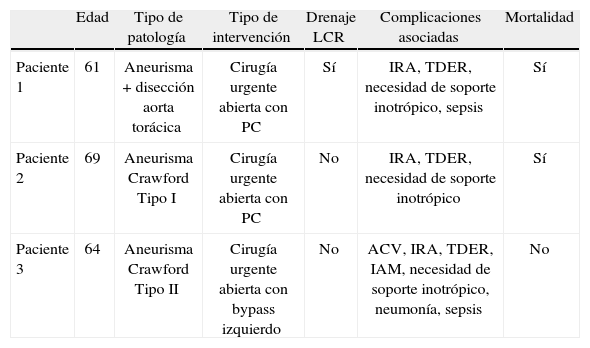Los resultados quirúrgicos en las enfermedades de la aorta torácica descendente y toracoabdominal han mejorado significativamente, aunque la morbimortalidad sigue siendo elevada. Como consecuencia de ello las técnicas terapéuticas endovasculares se presentan como alternativas atractivas. En este trabajo comparamos los resultados de la cirugía abierta sobre ambos segmentos aórticos con el tratamiento endovascular.
Material y MétodosEstudio retrospectivo de los pacientes intervenidos de patología sobre la aorta torácica descendente y toracoabdominal mediante cirugía abierta y tratamiento endovascular en nuestro hospital desde 1995 a 2009. Analizamos las características preoperatorias e intraoperatorias y los resultados postoperatorios de ambos grupos.
ResultadosSe revisaron 22 pacientes, 10 sometidos a cirugía abierta y 12 a tratamiento endovascular. Las etiologías con indicación quirúrgica fueron aneurismas, disecciones y ambos en el 40%, 30% y 30% en el grupo de cirugía abierta y con el 66,7%, 33,3% y 0% en tratamiento endovascular. La patología de origen traumático se correspondió con el 20% y 16,7% y la cirugía de urgencia con el 40% y 16,2% en el grupo de cirugía abierta y endovascular respectivamente. No hubo diferencias estadísticamente significativas en las características preoperatorios (excepto en la edad de los pacientes) entre ambos grupos. Se observaron diferencias estadísticamente significativas en los tiempos quirúrgicos, estancia en unidad de cuidados críticos y estancia hospitalaria, y en el tiempo de intubación (p<0,05).
DiscusiónLa incidencia de complicaciones postoperatorias en el grupo de cirugía abierta de la aorta torácica descendente es similar a los centros con un volumen reducido de enfermos. Se observa una tendencia hacia una reducción de la morbimortalidad así como diferencias estadísticamente significativas en el tiempo de intubación, la estancia en la unidad de cuidados críticos y hospitalaria en el grupo de tratamiento endovascular.
Outcomes of surgical treatment of the descending thoracic aorta have improved markedly, although high associated morbidity and mortality continue to be a concern. Endovascular treatments are therefore attractive alternatives to open surgery. We compared outcomes of endovascular treatment to outcomes of open surgery on both aortic segments.
Material and MethodsRetrospective study of patients treated for descending thoracic and thoracoabdominal aorta disease by means of open surgery or endovascular treatment in our hospital between 1995 and 2009. We analyzed preoperative characteristics, intraoperative variables, and postoperative results in both groups.
ResultsWe retrieved the cases of 22 patients, 10 who underwent open surgery and 12 who received endovascular treatment. Surgery was indicated to treat aneurysm (40%), aortic dissection (30%), or both (30%) in the open surgery group. In the endovascular treatment group, 66.7% had aneurysm, 33.3% dissection, and 0% both. Trauma was involved in 20% of the open surgeries and 16.7% of the endovascular procedures. Forty percent of the open surgery cases and 16.2% of the endovascular interventions were emergencies. Patient age was the only statistically significant between-group difference in preoperative characteristics. Postoperative complication rates were similar. Significant differences were observed in duration of surgery, lengths of critical care unit and total hospital stays, and intubation time (P<.05).
ConclusionsThe incidence of postoperative complications in the group of patients undergoing open surgery on the descending thoracic aorta was similar to incidences reported by other hospitals with moderate caseloads. A trend toward reduced morbidity and mortality in the endovascular treatment group was observed, and this group had significantly shorter times of intubation and lengths of critical care unit and hospital stays.
Artículo
Comprando el artículo el PDF del mismo podrá ser descargado
Precio 19,34 €
Comprar ahora










